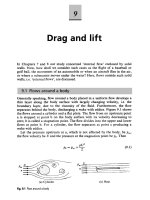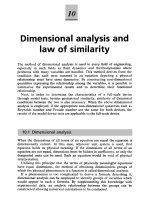Introduction to Static Failure Theories
Bạn đang xem bản rút gọn của tài liệu. Xem và tải ngay bản đầy đủ của tài liệu tại đây (66.19 KB, 5 trang )
†
Text refers to Mechanical Engineering Design, 7
th
edition text by Joseph Edward Shigley, Charles R.
Mischke and Richard G. Budynas; equations and examples with the prefix T refer to the present tutorial.
M
ECHANICAL
E
NGINEERING
D
ESIGN
T
UTORIAL
6, P
ART
A: I
NTRODUCTION TO
S
TATIC
F
AILURE
T
HEORIES
A
PPROACH
Theories have been developed for the static failure of metals based upon the two classes of material
failure; ductile metals yield while brittle metals fracture. Thus separate failure theories exist for
ductile and brittle metals:
Failure Theories for Ductile Materials
1. Maximum Shear Stress (MSS)
2. Distortion Energy (DE)
3. Ductile Coulomb-Mohr (DCM)
Failure Theories for Brittle Materials
1. Maximum Normal Stress (MNS)
2. Brittle Coulomb-Mohr (BCM)
These theories have grown out of hypotheses and experimental data in the following manner.
1. Experimental failure data is first collected through tensile tests.
2. The state of stress is correlated to the experimental data using Mohr’s circle plots.
3. A failure theory is developed from a concept of the responsible failure mechanism.
4. A design envelope is established based upon the theoretical and empirical design
equations.
In light of the extensive dependence of failure theories on experimental data, we will first review
the acquisition and correlation of tensile test data to failure theory. Subsequently, the criteria and
application of specific failure theories will be discussed.
T
ENSILE
T
EST
TEXT FIGURE 3-1: A typical tension-test specimen. Some of the standard
dimensions used for d
0
are 2.5, 6.25, and 12.5 mm and 0.505 in, but other sections and
sizes are in use. Common gauge lengths l
0
used are 10, 25, and 50 mm and 1 and 2 in.
d
0
l
0
Shigley, Mischke & Budynas Machine Design Tutorial 6: Static Failure Theories 2/5
The tensile test is a standardized test (ASTM Standard E8 or E8m) and thus allows for the sharing
of experimental data amongst researchers, typically in the form of stress-strain curves. Standard
dimensions for the test-specimen are provided in Text Figure 3-1 while a comparison of
characteristic stress-strain curves for ductile and brittle materials are shown in Text Figure 3-2.
These engineering stress-strain diagrams graphically demonstrate the difference in the failure
behavior of ductile and brittle metals, and the need for separate failure criteria. However, the curves
do not represent true values of stress and strain; rather, they are calculated based upon the original
specimen cross-sectional area, prior to loading.
2
0
0
0
0
4
Engineering Stress (Text Eq. 3-1)
Engineering Strain (Text Eq. 3-2)
PP
A
d
ll
l
σ
π
ε
==
−
=
Referring to Text Fig. 3-2 (a), point el, the elastic limit, defines the onset of permanent set
while point a represents 0.2 percent permanent set with respect to the original gauge length
(ε = 0.002).
A measure of the “true” stress and strain can be obtained by taking simultaneous
measurements of the load and cross-sectional area during the tensile test experiment. Text
TEXT FIGURE 3-2: Stress-strain diagram obtained from the standard tensile test
(a) Ductile material; (b) brittle material. pl marks the proportional limit; el, the
elastic limit; y, the offset yield strength as defined by offset strain Oa; u, the
maximum or ultimate strength; and f, the fracture strength.
a
Strain ε
(b)
u, f
Strain ε
(a)
O
ε
u
a ε
y
ε
f
S
u
S
f
S
y
u
f
y
el
pl
Stress σ = P/A
0
y
S
ut
S
y
Shigley, Mischke & Budynas Machine Design Tutorial 6: Static Failure Theories 3/5
Figure 3-4 shows a typical true stress-strain diagram for a ductile material. The curve
between points u and f corresponds to a reduction in stress as the specimen necks down.
C
ORRELATION OF
S
TATE OF
S
TRESS WITH
T
EST
D
ATA
For design, we need to relate the expected state of stress in a part to the actual state of stress
and thus, the material strength, as determined through the tensile test. We accomplish this
by applying principal stresses since they characterize a state of stress independent of the
original coordinate system.
σ
f
σ
u
ε
u
True strain
f
u
True stress
ε
f
TEXT FIGURE 3-4: True stress-
strain diagram plotted in Cartesian
coordinates.
TEXT FIGURE 3-3: Tension specimen
after necking.
y
(a) State of stress for simple tension.
(b) Principal stresses for simple tension.
FIGURE 6A-1: Correlation of state of stress
with principal stresses for simple tension.
x
0
/
x
P A
σ
=
0
yx xy
ττ
==
0
y
σ
=
0
y
σ
=
0
/
x
P A
σ
=
0
yx xy
ττ
==
1
σ
23
0
σσ
==
1
σ
Shigley, Mischke & Budynas Machine Design Tutorial 6: Static Failure Theories 4/5
Since the tensile test generates a uniaxial state of stress, the principal stresses can be defined
as,
1axial 23
0
and 0
P
A
σσ σσ
== ==
When plotted on a Mohr’s circle diagram, these stress values translate into what looks like a
single circle passing through the origin where
2
σ
is coincident with
3
.
σ
Actually, there are
still three circles on the Mohr’s circle diagram. Two circles, defined by principal stresses
1, 2
()
σσ
and
1, 3
()
σσ
, are drawn on top of each other. The third circle degenerates to a point
defined by principal stresses
2, 3
()
σσ
.
D
EVELOPMENT OF
S
TATIC
F
AILURE
T
HEORIES
Design for static loading dictates that all loading variables remain constant:
1. Magnitude of load is constant;
2. Direction of load is constant;
3. Point of application of the load is fixed.
These conditions, in conjunction with criteria specific to ductile and brittle materials, have
been used in the development of the static failure theories outlined earlier.
Characteristics of Ductile Materials
1. The strain at failure is,
0.05
f
ε
≥
, or percent elongation greater than five percent.
2. Ductile materials typically have a well defined yield point. The value of the
stress at the yield point defines the yield strength, S
y
.
3. For typical ductile materials, the yield strength has approximately the same value
for tensile and compressive loading
().
yt yc y
SSS≈=
τ
σ
3
σ
2
σ
1
σ
FIGURE 6A-2: Mohr’s circle for simple tension.
Shigley, Mischke & Budynas Machine Design Tutorial 6: Static Failure Theories 5/5
4. A single tensile test is sufficient to characterize the material behavior of a ductile
material, S
y
and S
ut
.
Characteristics of Brittle Materials
1. The strain at failure is,
0.05
f
ε
≤
or percent elongation less than five percent.
2. Brittle materials do not exhibit an identifiable yield point; rather, they fail by
brittle fracture. The value of the largest stress in tension and compression
defines the ultimate strength, S
ut
and S
uc
respectively.
3. The compressive strength of a typical brittle material is significantly higher than
its tensile strength, ( ).
uc ut
SS
4. Two material tests, a tensile test and a compressive test, are required to
characterize the material behavior of a brittle material, S
ut
and S
uc
.
S
UMMARY
This tutorial has attempted to provide a focused introduction to the development of static failure
theory by summarizing the theories associated with specific material classifications. In addition, the
experimental and analytical models, which have been employed historically to relate the
experimental data to strength quantities used for static design, are presented. Subsequent tutorials,
Static Failure of Ductile Materials and Static Failure of Brittle Materials, will respectively provide
detailed reviews and examples, respectively, of the failure theories associated with ductile and
brittle materials.









